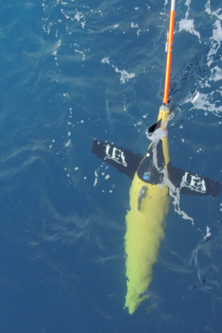 A sea glider. Photograph: Marine Insight
A sea glider. Photograph: Marine InsightJust this week, a new study has appeared which describes a clever method for measuring the flows of ocean currents and their impacts on ice shelves. This study has identified a major mechanism for melting ice in the Southern Hemisphere.
The paper, co-authored by Andrew Thompson, Karen Heywood, and colleagues is very novel. The scientists used sea gliders to identify water flows that bring warm waters to the base of ice shelves in Antarctica. As I’ve written before, ocean currents are complex; you cannot neglect their impact on the Earth’s climate.
In some parts of the ocean, dense waters near the surface fall to the ocean floor and spread across the globe. In other regions, waters from the deep rise to the surface. Similarly, waters move horizontally and carry their heat with them. In some cases the surface waters and the mid-depth waters flow in different directions.
But regardless of the direction of flow, these waters carry energy with them. This process, often called “advection,” results in a major redistribution of heat across the globe. Sometimes, warm waters flow into cold regions, transferring heat, and melting ice. It is this phenomenon that was at the center of the current paper.
Fluids sometimes move as large directional masses (sometimes called bulk motion) caused by some agent of motion, for instance winds that blow over the surface and drag waters. Other motions are characterized by swirls and eddies – not unidirectional flow. This type of motions is called eddy-induced transport. A determination of which type of transport dominates and where they dominate is important to understanding Antarctic ice melt.
The Caltech and UEA scientists used sea gliders to make their measurements. Sea gliders are devices that move up and down in the ocean waters, taking samples of water properties, while they glide. Sea gliders are a relatively new measurement tool and they provide high-resolution, high-quality data.
 A sea glider. Photograph: Marine Insight
A sea glider. Photograph: Marine Insight
Three such gliders were deployed in the Weddell Sea in early 2012. Together, the gliders made 750 dives to depths of 1000 meters or to within 20 meters of the sea floor. They completed their dives every four hours, making measurements of temperature, salinity, oxygen levels, and optical properties every five seconds. The data was then transmitted wirelessly to a data collection station.
The data showed that eddy-transport and surface-wind-caused motion are comparable in their contribution to water circulation. They showed however, that the eddy motion is largely confined to the warm intermediate water layers. The penetration of the warm waters to the ice shelves is believed to be responsible for the dramatic ice loss that has been observed in the Antarctic.
I asked Dr. Heywood about her research and she told me,
Posted by John Abraham on Thursday, 13 November, 2014
 |
The Skeptical Science website by Skeptical Science is licensed under a Creative Commons Attribution 3.0 Unported License. |